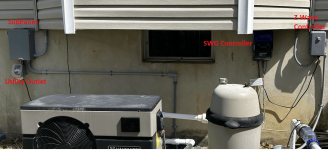So I have been looking at pools for a while and trying to decide what to buy size wise based upon where in the yard I can place it. The biggest factor for me was getting electric from the panel to the backyard for the pool. I have a 200 amp panel that is on the right side of the house, I wanted to place the pool more on the left side of the back yard, so I felt to come out the side of the house where the panel is I would have to trench up the side of the house into the back yard, around the patio and then across the entire yard and felt it would be a ton of work. So recently we had the basement renovated and I had electrical work done, I had the electrician run a dedicated line across the house through the basement out the left side of the house on a 20amp circuit (we used 12/2 romex for the run). If I had to guess I'd say this run itself is probably 30ft already. My plan was when we got the pool to run the PVC pipe off the box on the side of the house down into the ground and trench out to where the pool is, using THHN wire.
I am looking at a 24ft round pool and I was looking at a 190sqft 2hp dual speed pump. The pump says at high speed it pulls 10.5 amps and low speed 3.5 amps. Inside the owners manual of the pump it says for the 1.5-2hp pump for a 0-100' to use 12 gauge wire, then it says for 101-200' to use 8 gauge wire.
I wanted to place the pool further towards the back of the yard to not cut off most of the yard area, that would place the pool pump / equipment about 100 feet from the house, so if I had to guess i'm in the 130-150ft range. So here are some of my questions I am trying to answer
I am looking at a 24ft round pool and I was looking at a 190sqft 2hp dual speed pump. The pump says at high speed it pulls 10.5 amps and low speed 3.5 amps. Inside the owners manual of the pump it says for the 1.5-2hp pump for a 0-100' to use 12 gauge wire, then it says for 101-200' to use 8 gauge wire.
I wanted to place the pool further towards the back of the yard to not cut off most of the yard area, that would place the pool pump / equipment about 100 feet from the house, so if I had to guess i'm in the 130-150ft range. So here are some of my questions I am trying to answer
- If I keep to my plan, would I remove the 12/2 romex I had run through the house to the side and replace it with 8/2 romex to the be splice in the box on the side of the house with THHN 8guage wire into PVC pipe and trenched the 100 or so feet out to the pool? I would also assume if I wanted to not splice I could run all THHN wire from the breaker, through the basement, out the side of the house down into the trench and out to the pool area and just PVC pipe it all even through the joists in the house? This probably costs more but no splice would help with voltage drop? Just asking generally here if either way could be done.
- If I wanted to keep the 12/2 romex already run through the house out to the side (which is already roughly 30ft maybe less hard to measure exactly), if I splice that to THHN 12 gauge wire and run roughly another 50ft and place the pool in that area would that be acceptable, I'd be under the 100' and should be okay?
- If I wanted to run a salt system as well, would this single run be okay to run both pump and salt system or would I need a 2nd feed off the breaker out to the area for that?


